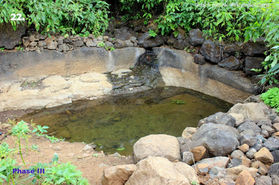

In the land of enchanting mythologies and divine folklore, India is adorned with rivers that hold profound spiritual significance. Among these sacred waterways, the Godavari River stands tall, entwined with countless mythical tales and revered by millions. Let us embark on a journey into the realm of mythology and explore the captivating significance of the Godavari River.
According to Hindu mythology, the Godavari River is believed to be the celestial daughter of Lord Brahma, the creator of the universe. The Godavari river's story originates from the Kotirudra Samhita of the Shiva Purana. During a hundred-year drought, the sage Gautama was meditating on Brahmagiri mountain. He sought rain from Varuna, the ocean god, but was denied as it went against the Gods' wishes. Instead, Gautama asked for divine everlasting water. Varuna instructed him to dig a ditch and filled it with sacred water, declaring that it would become renowned in Gautama's name. Gautama and other sages utilized this water to revive their crops.
However, a dispute arose when Gautama's disciples were stopped from accessing the water by other sages' wives. Gautama's wife, Ahalya, collected water first, causing anger among the sages. Seeking revenge, the sages prayed to Ganesha, who advised against harming someone who had done them good. Ignoring the advice, they compelled Ganesha to intervene.
Taking the form of a feeble cow, Ganesha ate Gautama's crops. Gautama, attempting to shoo away the cow, unintentionally caused its demise with a blade of grass. Realizing he committed Gohatya (cow-slaughtering), a grave sin, Gautama left his hermitage to repent. He circumambulated the Brahmagiri mountain, confessed his sin to everyone he encountered, and worshiped Shiva through Lingams.
Eventually, Shiva appeared before Gautama, who sought absolution. Shiva reassured Gautama that he had committed no sins and that his mere presence made others sinless. Nonetheless, Gautama requested Ganga's presence to cleanse himself and others of their sins. Shiva granted Gautama "the essence of the earth and heaven," Gautama's inheritance from his father Brahma, to summon Ganga. Ganga agreed to stay on the condition that Shiva also stayed, and Shiva manifested as Tryambakeshwara, a Jyotirlinga.
The Gautami river, now known as the Godavari river, flowed with Ganga's presence. Gautama and his disciples bathed in the river to purify themselves. Even the sages who sought revenge desired cleansing. Initially hesitant, Ganga agreed to purify them after Gautama's persuasion. Gautama dug a ditch for Ganga to emerge and cleanse the sages of their sins, which became the famous Kushavartha Thirtha at the Tryambakeshwara temple.
Ramayana and Shri Prabhu Rama: The Godavari River occupies a prominent place in the epic Ramayana, an ancient Indian saga. Lord Rama, the seventh incarnation of Lord Vishnu, along with his wife Sita and loyal brother Lakshmana, embarked on an arduous exile in the forests. During their exile, the Godavari River bestowed its grace upon them, providing them with solace and sustenance amidst their trials and tribulations.
The Sacred Triveni Sangam: The Godavari River, along with the River Saraswati and Yamuna , forms the sacred Triveni Sangam in Nashik, Maharashtra. The Triveni Sangam is believed to be a sacred confluence. People from all over the world come here to perform rituals, seeking spiritual cleansing and liberation from the cycle of life and death.
Kumbh Mela: Every twelve years, the Godavari River witnesses an awe-inspiring spectacle known as the Kumbh Mela. This grand religious gathering attracts millions of devotees from around the world. Pilgrims take a dip in the holy river, believing that it purifies their souls and free them of their sins. The Kumbh Mela indicates the enduring mythological and spiritual importance of the Godavari River.
Temples and Pilgrimage Sites: Along the banks of the Godavari River, numerous temples and pilgrimage sites stand as beacons of faith and devotion. The city of Nashik houses the famous KalaRam temple and the ancient Trimbakeshwar Shiva temple. Rajahmundry, in Andhra Pradesh, is home to the revered Koti Lingeshwara Temple. These sacred abodes offer solace and divine blessings to the devotees who visit them. The Godavari River weaves a tapestry of mythology, spirituality, and devotion, capturing the hearts of millions. The Godavari River resonates with the essence of India's ancient heritage. As pilgrims immerse themselves in its sacred waters and seek divine intervention, the Godavari River remains a timeless symbol of faith, reverence, and transcendence
Kunda Rejuvenation
The Brahmagiri mountain is the origin of the Godavari River, and it has more than 108 water bodies on its summit, known as Kund. These Kund are significant in our traditions as they are worshipped and referred to as Tirtha, but they also play a crucial role in water storage. These water bodies were created through years of research and studies in ancient India. The Namami Goda Foundation has successfully preserved many of them, and we are currently working on them along with Satsang Foundation , on Bramhagiri and Godavari Bank as they will a major source of water for the locals during the summer.



























